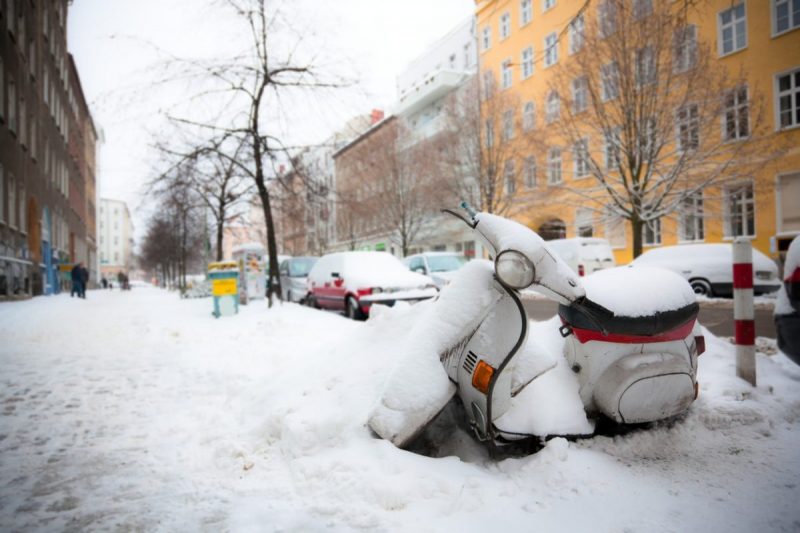How to Safely Drive a Scooter While the Weather’s Still Cold

 We’re reaching the end of the winter months, and while it’s still cold outside, with the right precautions you can still break out your scooter for a little fun. Riding your scooter in bad weather doesn’t have to mean bad riding. If you must head out, brave the icy, wet roads with confidence, and more importantly with caution.
We’re reaching the end of the winter months, and while it’s still cold outside, with the right precautions you can still break out your scooter for a little fun. Riding your scooter in bad weather doesn’t have to mean bad riding. If you must head out, brave the icy, wet roads with confidence, and more importantly with caution.
Cold and stormy weather poses a great danger to any motorist, but especially to riders on two wheels, emphasizing the importance of Scooter Insurance and the right safety preparations. There are several things to consider when riding a scooter in winter conditions, mostly importantly weather-appropriate gear and seasonal driving techniques.
Driving Safety
When it’s cold out, there are a few things you’ll need to do differently on the roads.
- Signal and brake earlier to ensure other drivers around you have plenty of time to distance themselves.
- Don’t ride for 30 minutes after rain. If it hasn’t rained in a few days, the roads are particularly dangerous the first half hour after a fresh shower. If you’re already out and about, it’s best to pull over.
- Avoid riding at night. Inclement weather already brings lower visibility, which gets even worse at night.
- Stay away from black ice. When snow and ice melt, then suddenly freezes over again, black ice is the result and is extremely dangerous to ride on.
- Be prepared for wind. Lean into the wind a bit if there’s a sudden gust or a constant stream. Keep your scooter on the side of the lane where the wind is coming from in case a gust of wind pushes you to the other side.
Wintertime Gear
Wear gear that protects you from elements like wind chill, rain, snow, and even hypothermia and frostbite.
- Head: A full-coverage helmet can keep your face and head dry and protected from wind chill and frostbite.
- Body: Start with thermal underwear, long socks, and a long-sleeve T-shirt. Make your second layer your normal clothes for the day and top it off with your scooter jacket and a scarf or neck gasket. If you want to stay extra dry, try plastic parkas and boot covers. Wear brightly colored items or metallic reflectors so other drivers can see you in low-visibility conditions.
- Legs: Snowmobile or ski pants will offer you water-resistant protection. Try them on over jeans or slacks to make sure you can layer with them.
- Hands: Use a pair of insulated gloves that keep your hands toasty, without hampering your control of the scooter with too much bulk or padding. Gloves with pre-curved fingers that help you get a better feel for your handlebars might be your best bet.
- Feet: Heavy riding boots are crucial in harsh conditions. After all, cold, wet feet are both an accident risk and a health hazard as well.
There’s a lot to keep in mind when learning how to ride your scooter, especially in the winter. If an incident were to occur, the right coverage can get you back on the road in no time.
About Byrnes Agency
At Byrnes Agency, we offer auto insurance solutions that can be tailored to meet your specific needs. Whether you have an old classic car or a brand-new model, we have the right coverage for you. To learn more about our products, contact us today at one of our two locations.
If you’ve enjoyed what you’ve read here and would like to know when we’ve published a new blog post, please “like” us on our Facebook page, and share this with your Connecticut neighbors.
Phone: (860) 774-8549
394 Lake Rd
Dayville, CT 06241
United States
info@byrnesagency.com
Hours of Operation: Monday- Friday 9:00am-5:00pm
Phone: (860) 886-5498
6 Consumers Avenue
Norwich, CT 06360
United States
info@byrnesagency.com
Hours of Operation: Monday- Friday 9:00am-5:00pm
Tags: CT Scooter Insurance Policy, Scooter, Scooter Insurance, Scooter Safety, Winter Scooter Driving, Winter Scooter Safety
